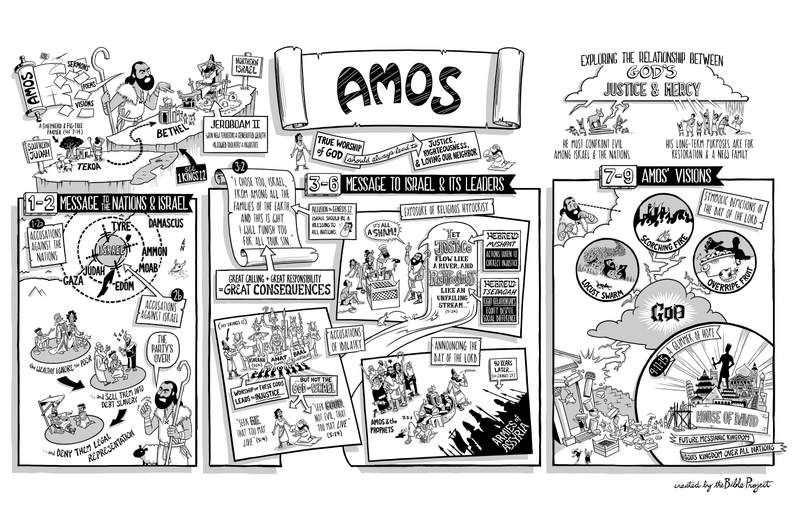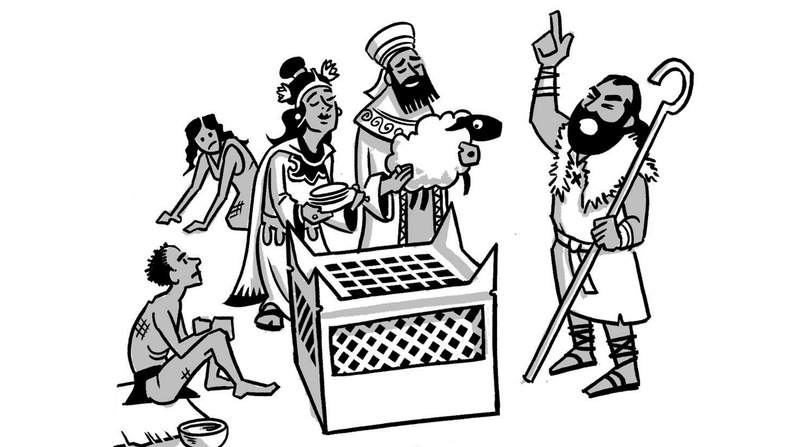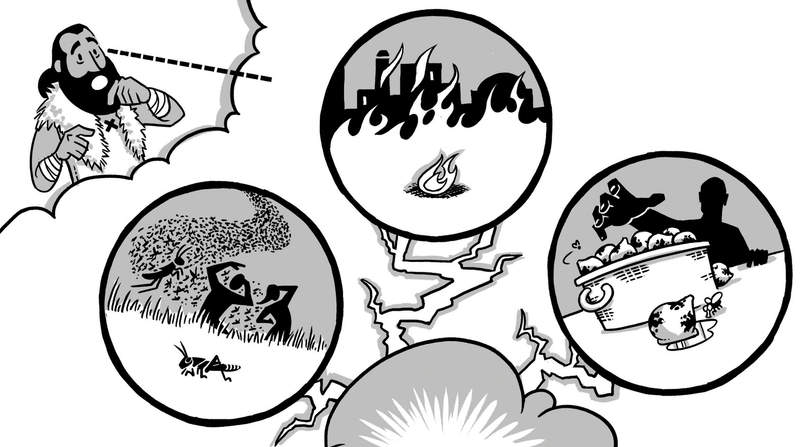The Book of Amos
About

One important aspect of the ancient TaNaK order of the Hebrew Bible is that the 12 prophetic works of Hosea through Malachi, sometimes referred to as the Minor Prophets, were designed as a single book called The Twelve. Amos is the third book of The Twelve.
Amos was a shepherd and fig tree farmer (Amos 7:14) who lived right near the border between northern Israel and southern Judah. The north had seized its independence about 150 years earlier (1 Kgs. 12) and was currently being ruled by Jeroboam II, a successful military leader. He won battles and new territory for Israel, which generated lots of new wealth. But in the eyes of the prophets, he was one of the worst kings ever. His wealth had led to social apathy, and he had allowed idol worship of the Canaanite gods, all of which led to injustice and neglect of the poor.
It got to the point where Amos couldn’t take it anymore. He sensed God’s call to trek up north to Bethel, an important city with a large temple, to start announcing God’s word to the people. This book is a collection of his sermons, poems, and visions uttered over the years. They were later compiled to give God’s people a sense of his divine message to the northern kingdom—a message we still need to hear today.
The book has a fairly clear design. Chapters 1-2 are a series of messages to Israel and the other nations. Chapters 3-6 are a collection of poems that express Amos’ message to the people of Israel and its leaders. Chapters 7-9 contain a series of visions Amos experienced that visually depict God’s coming judgment on Israel.
Who Wrote the Book of Amos?
Context
Key Themes
- The Day of the Lord
- God’s promise for a messianic king from the house of David
- Israel’s idolatry and neglect of the vulnerable
- God’s call for true worship as living by justice and righteousness
Structure
Amos 1-2: Accusations Against the Nations and Israel
The book of Amos opens with a series of short poems that accuse all of Israel’s neighbors of violence and injustice, which seems odd because the book’s opening line said that Amos spoke against Israel. As Amos names all these neighboring nations—Damascus, Gaza, Tyre, Edom, Ammon, Moab, and Judah—you can look at a map and see that he’s drawing a circle with Israel in the center, like a target in the crosshairs. When he does get to Israel, Amos unleashes a poetic accusation three times longer and more intense than any of the others. He accuses Israel’s wealthy of ignoring the poor and allowing grave injustice, specifically by allowing them to be sold into debt slavery and then denying them legal representation. Is this, Amos asks, the same family that was denied justice and enslaved in Egypt, who God graciously rescued from oppression? The party’s over, he says. God’s done putting up with this.
Amos 3-6: Exposing Israel’s Hypocrisy and Injustice
The opening to the next section explains why. God says,“I chose you Israel, from among all the families of the earth …” (Amos 3:2). It’s an allusion to Genesis 12, when God called the family of Abraham to become God’s blessing to all nations. God continues the thought by saying,“… this is why I will punish you for all your sin.” Israel had a great calling that came with great responsibility, and so their sin and rebellion will bring great consequences.
The following section brings together lots of Amos’ poems, in which you’ll see a few key themes repeated. First of all, he’s constantly exposing the religious hypocrisy of Israel’s wealthy people and religious leaders. He describes how they faithfully attend the religious gatherings and give offerings to God, all while neglecting the poor and ignoring injustice.

Amos says that it’s all a sham and that God hates their worship because it’s totally disconnected from how they treat other people. God says that a real relationship with him will transform a person and how they treat others. Amos’ call to true worship is to “let justice flow like a river, and righteousness like a never-failing stream” (Amos 5:24). These two words are important to Amos. Tsedaqah, or “righteousness,” refers to a standard of right, equitable relationship between people no matter their social differences. And mishpat, or “justice,” refers to concrete actions you take to correct injustice and create righteousness. Both of these values are to permeate the life of God’s people like a rushing stream fills a dry riverbed.
The next theme explored is Amos’ repeated accusations of Israel’s idolatry, which is connected with the previous themes about worship and justice. Remember when the northern kingdom broke away from southern Judah and their king built two new temples to rival Solomon’s one in Jerusalem, placing a golden calf in each (1 Kgs. 12)? Since then, Israel had only accumulated more idols, representing the gods of sex, weather, and war. In the prophets’ view, the worship of these gods always leads to injustice. These gods simply don’t require the same degree of justice and righteousness as the God of Israel, and they were actually immoral themselves. The God of Israel, on the other hand, can say at one moment, “Seek me, that you may live” (Amos 5:4), and later say, “Seek good, not evil, that you may live” (Amos 5:14). True worship of the Creator God of Israel is synonymous with doing good and spreading generosity and justice.
The final theme in these chapters is that because Israel and its king have rejected Amos and other prophets, God will send the Day of the Lord, a great and terrible act of justice, on Israel. More specifically, he predicts that a powerful nation will come to conquer and destroy their cities and take them away into exile. We know that his prediction came true some 40 years later. The Assyrian empire swooped in and did exactly as Amos said they would (2 Kgs. 17).
Amos 7-9: Visions of the Day of the Lord
The book closes with a series of visions Amos experienced, which are symbolic depictions of the coming Day of the Lord. He sees Israel devastated by a locust swarm and a scorching fire before being swallowed up like overripe fruit. In the final vision, Amos sees God violently striking at the pillars of Israel’s great idol temple at Bethel, and the whole building comes crumbling down. It’s an image of God’s justice on the leaders and gods of Israel—their end has come.

Yet the final paragraph suddenly offers up a glimmer of hope. Using the image of Israel as a destroyed building, God says that, out of the ruins, he will one day restore the house of David. In other words, God will bring a future messianic king from David’s line and rebuild the family of his people, which, surprisingly, includes the other nations. All of the devastation caused by Israel’s sin and God’s judgment will be reversed.
This final paragraph is really important. It’s the only sign of hope on the other side of judgment and helps us see how this book explores the relationship between God’s justice and mercy. While God must confront and judge evil among Israel and the nations, his long-term purposes are for restoration and creating a new family.
Through Amos’ words, we can still hear the call to learn from Israel’s hypocrisy and the disastrous consequences of their sins. It’s a call to embrace the true worship of God that should always lead to justice, righteousness, and loving our neighbor. That’s what the book of Amos is all about.